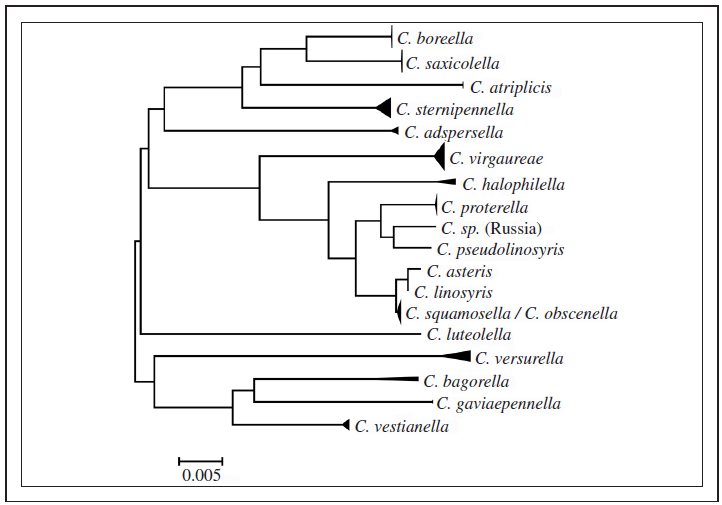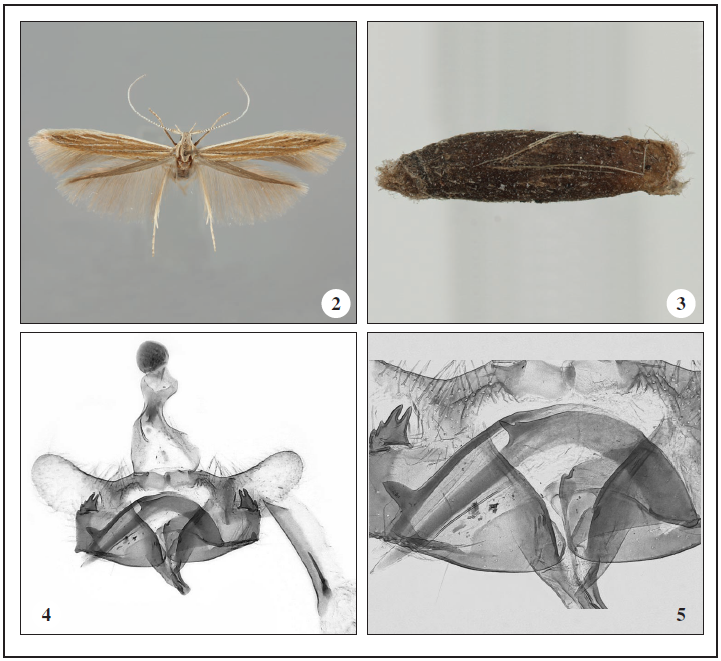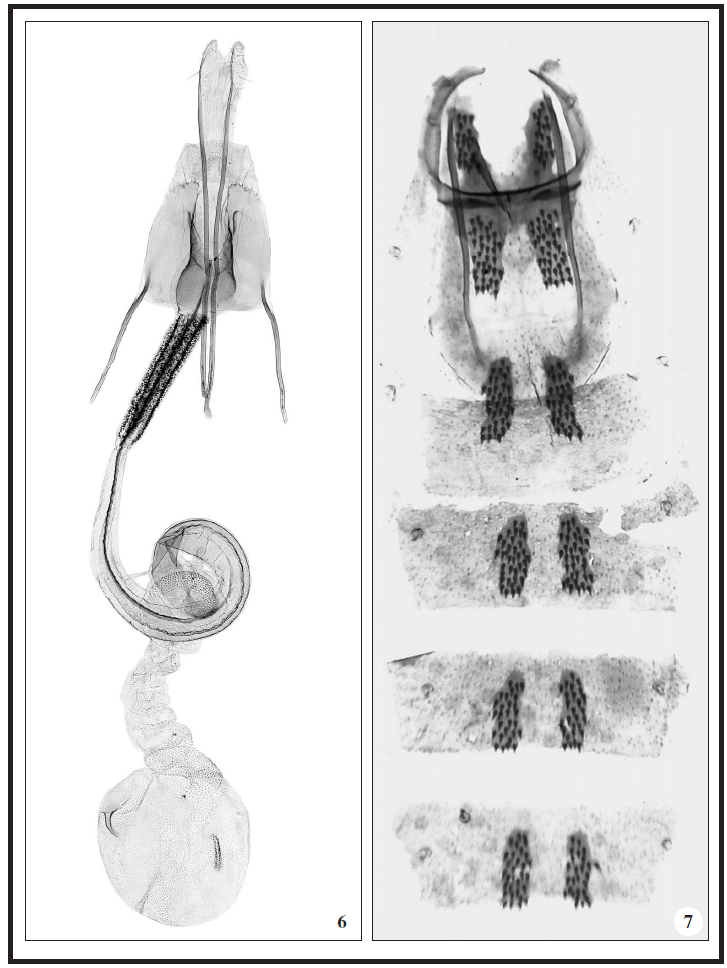

Coleophora proterella Wikström & Tabell, a new species belonging to C. virgaureae species-complex (Lepidoptera: Coleophoridae)
Coleophora proterella Wikström & Tabell, una nueva especie que pertenece al complejo de especies de C. virgaureae (Lepidoptera: Coleophoridae)
Coleophora proterella Wikström & Tabell, a new species belonging to C. virgaureae species-complex (Lepidoptera: Coleophoridae)
SHILAP Revista de lepidopterología, vol. 44, núm. 173, 2016
Sociedad Hispano-Luso-Americana de Lepidopterología
Recepción: 02 Febrero 2015
Aprobación: 22 Mayo 2015
Abstract: Coleophora proterella Wikström & Tabell, sp. n. is described as new. The new species belongs to the C. virgaureae species-complex. According to the genitalia structures it is closely related to C. obscenella Herrich- Schäffer, 1855, C. virgaureae Stainton, 1857, C. cinerea Toll, 1954, and according to the DNA barcode studies the closest species is C. squamosella Stainton, 1856. Photographs of the adult, genitalia and larval case of the new taxón are provided and the known distribution range is given.
Keywords: Lepidoptera, Coleophoridae, Coleophora proterella, Coleophora virgaureae species-complex, DNA, new species.
Resumen: Coleophora proterella Wikström & Tabell, sp. n. se describe como nueva. La nueva especie es pertenece al complejo de especies de C. virgaureae. De acuerdo a sus estructuras de la genitalia es relativamente próxima a C. obscenella Herrich-Schäffer, 1855, C. virgaureae Stainton,1857, C. cinerea Toll, 1954 y de acuerdo al código de barras del ADN la especie próxima es C. squamosella Stainton, 1856. De la nueva especie proporcionan fotografías de los adultos, genitalia y estuche larvario y el rango de distribución conocida.
Palabras clave: Lepidoptera, Coleophoridae, Coleophora proterella, Coleophora virgaureae complejo de especies, ADN, nueva especie.
Introduction
Coleophora virgaureae Stainton, 1857 is a species that has caused a great deal of confusión among collectors and taxonomists for a long time, due to the assumed variation in the structures of the male genitalia. In Europe three in genitalia closely similar species have been described during the last two centuries, viz. C. obscenella Herrich-Schäffer,1855, C. virgaureae Stainton,1857 and C. cinérea Toll,1954. Later BALDIZZONE (1981, 1992), after studying the type materials, synonymized C. virgaureae and C. cinerea with C. obscenella. During the last years, however, additional studies have revealed this synonymization unjustified and these three taxa have been reverted to distinct species (BALDIZZONE & TABELL, 2002).
In Northern Europe only one member of the C. virgaureae species-complex, on Solidago virgaurea L. living, widely spread and abundant C. virgaureae has been recorded so far. Surprisingly long flight period of the adults, from the last days of May to the end of September or even to the beginning of October, paid our attention, and we could find some small but steady differences in both male and female genitalia between the early and late flying specimens. As a result one further species of the C. virgaureae species-complex, Coleophora proterella Wikström & Tabell, sp. n. is described in the present paper. The new species has in genitalia also some similarities with C. squamosella Stainton, 1856 and some other species living on Aster L., but the shape of sacculus in male genitalia is a distinguishing character and these taxa are not treated here, except for C. squamosella.
The type specimens are deposited in the collection of the Finnish Museum of Natural History, University of Helsinki, Finland (MZH) and the private collections of the collectors.
Coleophora proterella Wikström & Tabell, sp. n.
Holotype 0 (GP 1244 JT) FINLAND, ES: Enäjärvi, 675:50, e. l. 10-VI-1992, Solidago virgaurea 22-VIII-1991, J. Tabell leg., Coll. MZH.
Paratypes (83 11, 44 00 ): Finland, V: Kiikala, 671:31, 17-VI-1986, 1 0 (GP BW851/-86); 18-VI- 1986, 43 11, 24 00 (GP BW800/-86 - BW812/-86, BW815/-86 – BW831/-86); 4-VI-2002, 10 11, 6 00, Bo Wikström leg. et coll.; 18-VI-1994, 3 11 (GP 4100 JT), 1 0, J. Junnilainen leg. & coll.; 4-VI- 2002, 12 11, 1 0, R. & J. Siloaho leg., coll. Siloaho; Finland, EH: Heinola, 6788:448, 16-VI-1984, 1 1 (GP 1239 JT), H. & J. Tabell leg., coll. Tabell; Finland, EH: Heinolan mlk, 679:44, e. l. 26-VI / 7-VII- 1992, Solidago virgaurea 5-IX-1991, 1 1 (GP 1050 JT), 3 00 (GP 1043 JT, 1046 JT, 1218 JT), J. Tabell leg. et coll.; Finland, EH: Hartola, 6839:448, e. l. 4-VI / 26-VI-1992, Solidago virgaurea 9-X- 1991, 5 11 (GP 323-5 JT, 328 JT, 333 JT), 3 00 (GP 320 JT, 322 JT, 604 JT), J. Tabell leg. et coll.; Finland, ES: Enäjärvi, 675:50, e. l. 4-IV / 15-IV-1989, Solidago virgaurea 28-VII-1988, 2 11 (GP 412 JT, 605 JT), 2 00 (GP 439 JT, 595 JT); 674:50, e. l. 10-VI / 4-VII-1992, Solidago virgaurea 22-VIII- 1991, 4 11 (GP 1045 JT, 1225 JT, 1232 JT, 1235 JT), 2 00 (GP 1237 JT, 1246 JT), J. Tabell leg. Et coll.; Finland, PPp: Oulu, e. l. 2006, Solidago virgaurea IX-2005, 1 1 (GP 4033 JT); e. l. 2014, Solidago virgaurea 11-VIII-2013, 1 0, J. Tabell leg. et coll.; Finland, PPp: Kiiminki, 722:344, e. l. VI- 2014, Solidago virgaurea 11-VIII-2013, 1 1, J. Tabell leg. et coll.
Other material examined: Hungary: Kecskemet 20 km E, near Kerekegyhaza village, 1 1 (GP 4920 JT), 30-VII-2007, T. Nupponen leg., coll. Tabell. Spain: 1 1 (gen. prep. 57364), 3 00 (gen. prep. 57363), coll. Seebold (Museo Nacional de Ciencias Naturales, Madrid). Portugal: Minho, Castro Laboreiro, Assureira, 1 1 swept from Solidago virgaurea, 5-IX-2013, M. Corley leg. et coll.
Diagnosis: C. proterella sp. n is a medium-sized coleophorid moth externally similar to C. virgaureae and C. obscenella. Other related species, C. squamosella Stainton, 1856 and C. cinerea, are slightly smaller (wingspan 11-13 mm, in C. proterella sp. n. 13-14 mm) and their forewings are darker brown. All five species can be reliably identified by means of genitalia examination. In the male genitalia the shape of phallotheca rods and sacculus are characteristic: in C. proterella sp. n. the upper rod (lateral aspect) bears a large apical tooth and the lower rod a triangular medial tooth at the junction of rods. In C. virgaureae the upper rod is toothless, but the lower rod bears a large triangular apical tooth and often few small medial ones. In C. obscenella the upper rod bears an apical tooth, the lower rod is toothless. In C. cinerea the upper rod is toothless or bears an apical tooth, the lower rod is equipped with a large, elongated tooth at the junction of rods. In C. squamosella both rods are armed with apical teeth, besides the lower rod bears a medial tooth. In occasional cases we have observed missing or extra teeth on either rod. In C. proterella sp. n. the sacculus is slightly narrower than in C. virgaureae and a single cornutus is shorter. In C. obscenella sacculus is very broad and its dorsal process long, cornuti more numerous. In C. cinerea dorsal process of sacculus and a cornutus are longer than in C. proterella sp. n. In C. squamosella sacculus is markedly narrower.
In the female genitalia the main distinguishing features are the shape of sterigma and the degree of sclerotization of ductus bursae; in C. proterella sp. n. the distal margin of sterigma is more oblique tan in other four species and the hook-shaped fold at the edge of medial excavation is situated more proximally (similarly with C. cinerea), in C. squamosella the fold is absent. In C. virgaureae, C. obscenella and C. cinerea the wide coil of ductus bursae is transparent or only slightly coloured, in C. proterella sp. n. it is brownish yellow and in C. squamosella darker, yellowish brown. The genitalia of C. squamosella and C. virgaureae are illustrated eg. In RAZOWSKI (1990) and those of C. obscenella and C. cinerea in BALDIZZONE & TABELL (2002).
Molecular diagnosis: 9 studied DNA samples of C. proterella sp. n. display a 0.06% mean K2P intraspecific variation, whereas C. virgaureae (n=14) shows 0.09% and C. squamosella (n=9) 0.0% mean variation. The mean interspecific divergence between C. proterella sp. n. and other in genitalia similar species is 1.16% - 4.3% (Table 1, Fig. 1). Although the interspecific difference between C. proterella sp. n. and C. squamosella is markedly lower than on average on Coleophoridae, it correlates perfectly with morphological features and bionomy and supports the status of C. proterella sp. n. as a distinct species. It is worth noticing that three Aster-feeding species, viz. C. obscenella, C. linosyris E. M. Hering, 1937 and C. asteris Mühlig, 1864 have very similar or identical barcode sequences with C. squamosella. At present there exist no DNA barcodes for C. cinerea in the BOLD.


Description: Imago (Fig. 2). Wingspan 13-14 mm. Head buff, postocular scales whitish. Labial palpus buff or greyish buff, lower side of middle segment whitish, apical segment whitish buff on inner side. Antenna white, basally often faintly ringed with light brown, thorax buff. Abdomen grey, upper Surface with paired spiny tergal discs. Forewing ochreous, costa narrowly creamy white to 2/3, the white lines along the veins to costa usually distinct, a few scattered dark brown scales in distal half of the wing, at fold a narrow dark brown stripe. Hindwing grey, cilia greyish. Foreleg fuscous above, whitish below, middle and hindlegs whitish. Sexual dimorphism very small, the female seems to be somewhat paler in colour. Abdominal structures (Fig. 7): No latero-anterior bars, latero-posterior bars thick. Transverse bar narrow, slightly curved, proximal edge evenly sclerotized, distal edge broadly thickened around sclerites.
Tergal sclerites about 3x longer than wide (3rd tergum), each covered with 30-35 conical spines Male genitalia (Figs. 4-5). Gnathos knob oval. Tegumen narrow, pedunculi rather long. Transtilla broad. Cucullus broad, ear-shaped, basally slightly narrower. Valvula as broad as cucullus, subtriangular, ventrally rounded, outer margin well delineated, densely covered with bristles. Sacculus broad, ventral margin almost straight, tooth at ventral angle distinct, lateral margin long, vertical, shallowly serrate; dorsal process long, two-pointed, inner tooth longer, extended to middle of cucullus. Phallotheca with two strongly sclerotized, slightly arched rods; upper rod bears one subapical tooth, and the lower rod bears one basal tooth at the junction of the rods. In vesica one needle-shaped cornutus with a basal plate.

2. Imago, female, holotype. 3. Larval case. 4-5. Male genitalia (GP 412 JT, paratype), “Finland, ES: Enäjärvi, e. l. 1989”.
Female genitalia (Fig. 6). Papillae anales long and slender. Posterior apophyses 3x longer than anterior apophyses. Sterigma elongate, slightly longer than broad, tapering off towards the apex. Distal margin rounded, medially deeply cleft and lined with subapical fold. Ostium bursae V-shaped, lined with few setae. Antrum elongate, asymmetrical, in anterior part rounded swelling on both sides. Ductus bursae long; spinulate section slightly longer than sterigma, medial section with wide coloured coil and a region with small spinules, anterior section with several coils. Corpus bursae spherical with one thornlike and one rasplike signum.

6. Female genitalia (GP 1244 JT, holotype), “Finland, ES: Enäjärvi, e. l. 1992”. 7. Abdomen.
Life history: The larva feeds on the seeds of Solidago virgaurea from late July to September, sometimes to October, usually together with the larvae of C. virgaureae. The larval case (Fig. 3) is similar to that of C. virgaureae, 5-6 mm, subcylindrical, trivalved, made of brown silk and covered with fine filaments of pappus. The flight period of adult is early, from late May to the beginning of July (in northern Europe). The habitats are warm, sandy fields and railway or road banks where the host plant flowers early.
Distribution: So far recorded from Finland, Sweden, Norway, Estonia, Latvia, Germany, Hungary, Portugal and Spain. This overlooked species most probably has a wider distribution in Europe. The figures of Spanish specimens of C. virgaureae by VIVES MORENO (1987) represent the genitalia of C. proterella sp. n.
Derivation of name: The species name is of Greek origin and means “earlier, early flying”, alluding to earlier flight period compared to that of C. virgaureae.
Agradecimientos
We thank Giorgio Baldizzone, Jan-Olov Björklund, Martin Corley, Lauri Kaila, Kauri Mikkola (†), Marko Mutanen, Kari Nupponen, Reijo Siloaho and Ivars Sˇ ulcs for different kind of help in preparing the present paper.
BIBLIOGRAPHY
BALDIZZONE, G., 1981.– Contributions à la connaissance des Coleophoridae. XXII. Nouvelles synonymies dans le genre Coleophora Hübner (II).– Nota lepidopterologica, 4(3): 63-79, 36 figs.
BALDIZZONE, G., 1992.– Catalogo commentato dei Coleoforidi (Lepidoptera, Coleophoridae) della Valle di Susa. Contribuzioni alla conoscenza dei Coleophoridae. LXXI.– Biogeographia, 16: 297-318.
BALDIZZONE, G. & TABELL, J., 2002.– Coleophora obscenella Herrich-Schäffer, 1855, C. virgaureae Stainton, 1857 and C. cinerea Toll, 1953, three distinct species (Lepidoptera: Coleophoridae).– SHILAP Revista de lepidopterología, 30(117): 15-26.
RAZOWSKI, J., 1990.– Motyle (Lepidoptera) Polski, Cze˛s´c´ XVI - Coleophoridae.– Monografie Fauny Polski, 18: 1-270, 1 pl.
VIVES MORENO, A., 1987.– Un género y doce especies nuevas para la fauna de España de la familia Coleophoridae Hübner, [1825] (Insecta: Lepidoptera).– SHILAP Revista de lepidopterología, 15(58): 119-136.
Notas de autor